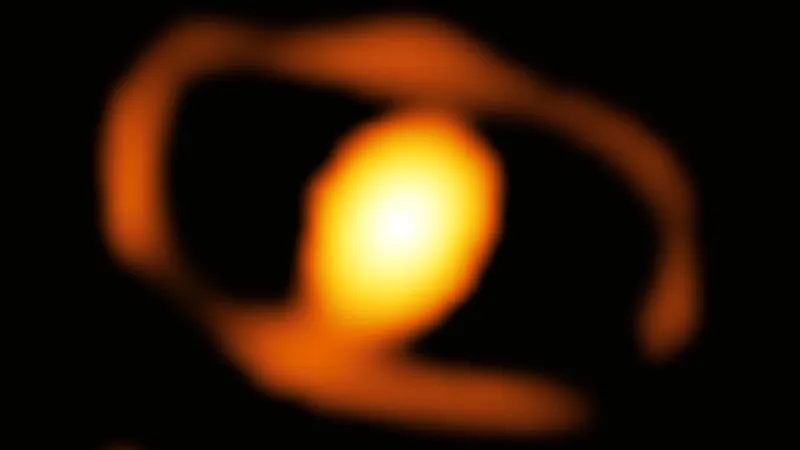
Astronomers Capture Stunning Detail of Distant Star WOH G64 Outside the Milky Way! (Amazing Images & Videos Inside)
2024-11-21
Author: Jia
Introduction
In an unprecedented breakthrough, astronomers have successfully captured a detailed image of a star located outside our Milky Way galaxy for the very first time. The focus of this monumental discovery is a colossal red supergiant star named WOH G64, situated an astonishing 160,000 light-years away in the Large Magellanic Cloud (LMC), a satellite galaxy that orbits the Milky Way.
About WOH G64
Affectionately referred to as the "behemoth star," WOH G64 dwarfs our sun, boasting a size that is approximately 2,000 times greater! The impressive capabilities of the Very Large Telescope Interferometer (VLTI) allowed scientists to not only view this distant star but also its surrounding cocoon of gas and dust, highlighting its tumultuous final phases leading up to a spectacular supernova explosion.
Scientists' Excitement
Keiichi Ohnaka, an astrophysicist from Universidad Andrés Bello and leader of the research team, expressed excitement about their findings, stating, "For the first time, we have succeeded in taking a zoomed-in image of a dying star in a galaxy outside our own Milky Way. We discovered an egg-shaped cocoon closely surrounding the star." This extraordinary observation hints at an imminent stellar demise, as WOH G64 releases vast amounts of material in a dramatic pre-supernova expulsion.
Advancements in Technology
While the VLTI has previously imaged numerous stars within the Milky Way, capturing WOH G64’s intricate details marks a significant leap forward for astronomical imaging. The team's work spans back to investigations in 2005 and 2007; however, only with the recent advancements of a second-generation VLTI instrument called "GRAVITY," which integrates light from four telescopes, has it been possible to document such faint celestial objects.
Dimming Phenomenon
Interestingly, WOH G64 has shown signs of dimming over the past decade, a phenomenon attributed to the layers of stellar material being shed to form its unique egg-shaped envelope. Gerd Weigelt, a professor at the Max Planck Institute for Radio Astronomy, noted, "We have found that the star has been experiencing a significant change in the last 10 years, providing us with a rare opportunity to witness a star’s life in real-time."
Red Supergiant Evolution
The process of a red supergiant star shedding layers lasts thousands of years and is an essential component of stellar evolution. Director of Keele Observatory, Jacco van Loon, has dedicated decades to observing WOH G64 and pointed out its status as one of the most extreme of its type, emphasizing that any drastic changes could mean it is nearing its explosive end.
Potential Companion Star
The unusual shape of the cocoon encasing WOH G64 could also suggest the presence of a hidden companion star exerting gravitational pull, drawing material and influencing the star's behavior.
Future Observations
While this groundbreaking image offers a spectacular view of WOH G64, the outlook for further observations is uncertain. As the behemoth star continues to shed gas and dust, it will likely grow dimmer, presenting a challenge for future imaging. However, astronomers are hopeful that enhancements to the VLTI, particularly the upcoming GRAVITY+ instrument, will allow them to continue monitoring WOH G64 as it journey towards its inevitable cosmic finale.
Conclusion
Stay tuned for more updates and images from the frontiers of space exploration, as astronomers delve deeper into the secrets of our universe!



 Brasil (PT)
Brasil (PT)
 Canada (EN)
Canada (EN)
 Chile (ES)
Chile (ES)
 España (ES)
España (ES)
 France (FR)
France (FR)
 Hong Kong (EN)
Hong Kong (EN)
 Italia (IT)
Italia (IT)
 日本 (JA)
日本 (JA)
 Magyarország (HU)
Magyarország (HU)
 Norge (NO)
Norge (NO)
 Polska (PL)
Polska (PL)
 Schweiz (DE)
Schweiz (DE)
 Singapore (EN)
Singapore (EN)
 Sverige (SV)
Sverige (SV)
 Suomi (FI)
Suomi (FI)
 Türkiye (TR)
Türkiye (TR)